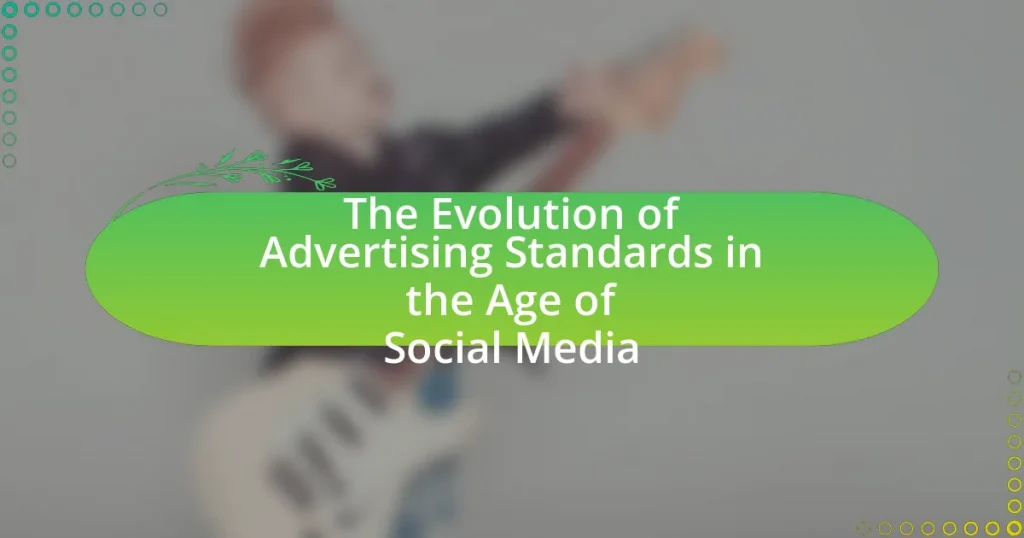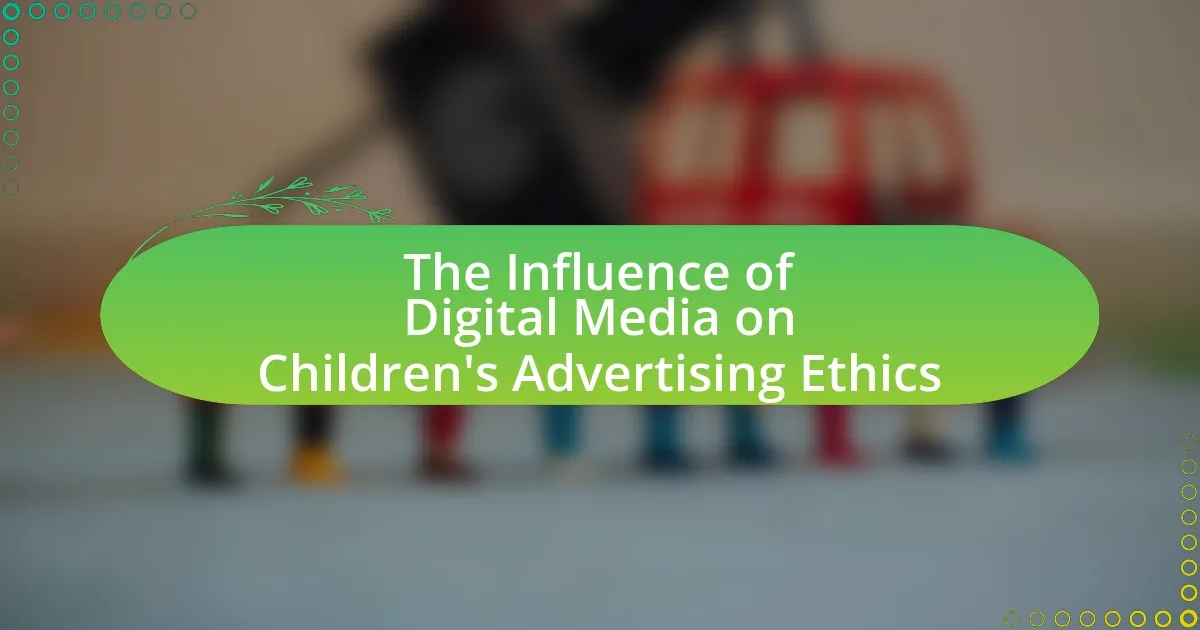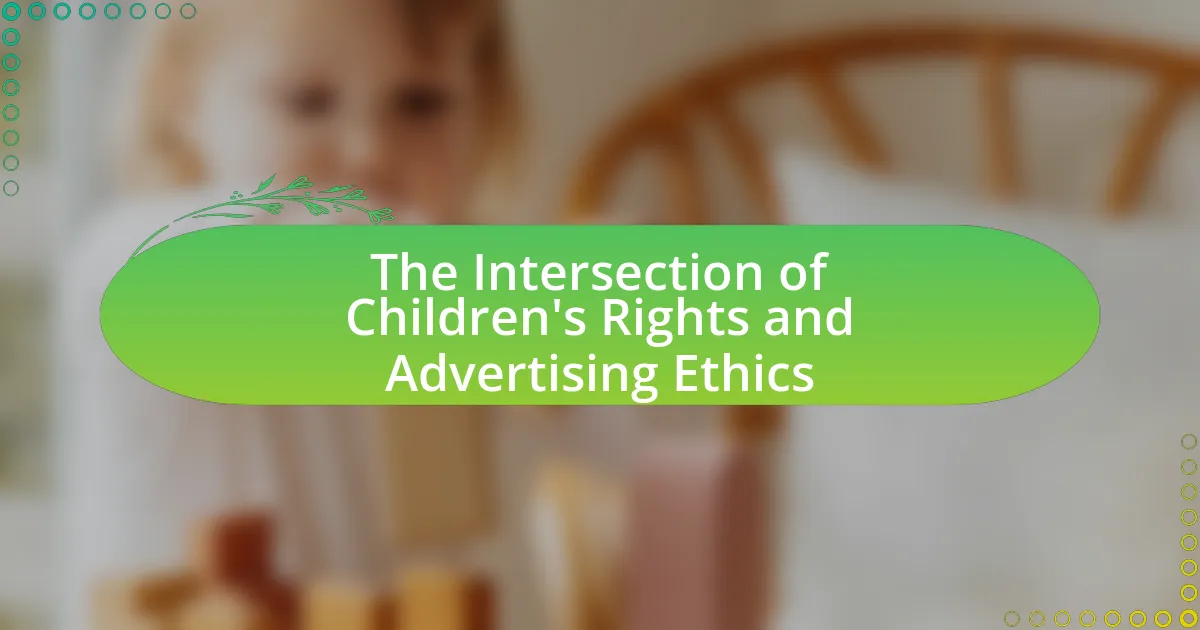The article examines the evolution of advertising standards in the context of social media, highlighting the importance of guidelines that ensure honesty, fairness, and transparency in advertising practices. It discusses the historical development of these standards, influenced by regulatory bodies such as the Federal Trade Commission (FTC) and significant events that shaped consumer protection laws. The article also explores how social media has transformed advertising practices, emphasizing the need for transparency and authenticity, as well as the unique challenges advertisers face in this digital landscape. Key changes in regulations and best practices for brands are outlined, focusing on maintaining compliance and effectively engaging with audiences while adhering to advertising standards.
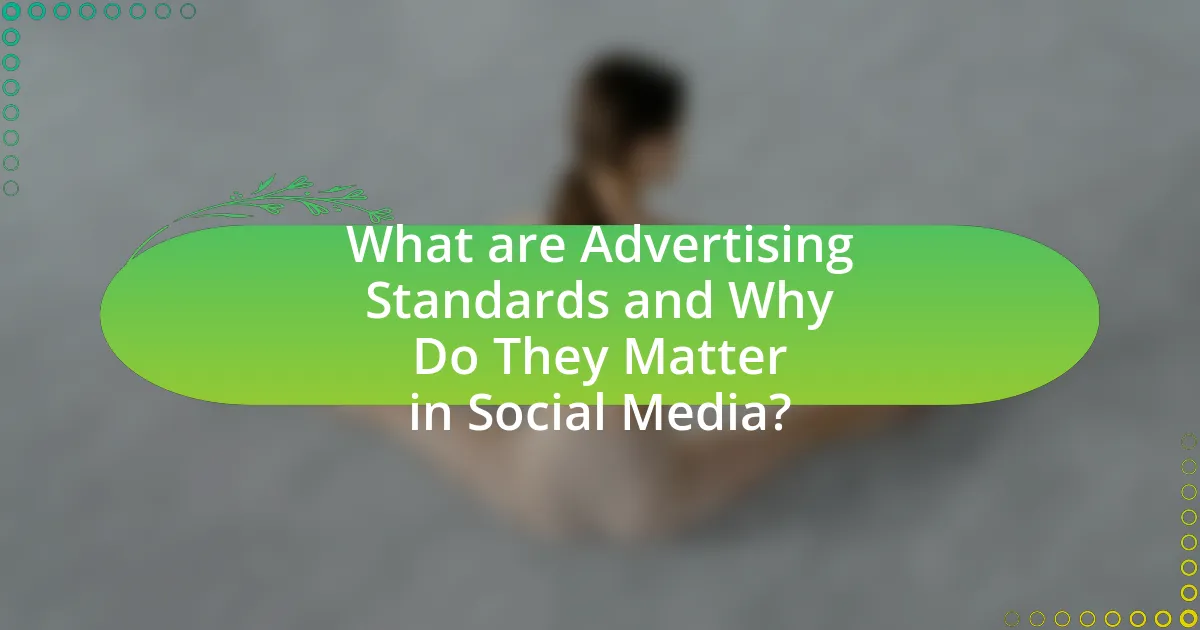
What are Advertising Standards and Why Do They Matter in Social Media?
Advertising standards are a set of guidelines and regulations that govern the content and practices of advertising to ensure honesty, fairness, and transparency. These standards matter in social media because they help protect consumers from misleading information and unethical marketing practices, which can be prevalent in the fast-paced digital environment. For instance, the Federal Trade Commission (FTC) in the United States enforces rules that require influencers to disclose paid partnerships, thereby promoting transparency and trust between brands and consumers. This regulatory framework is essential for maintaining the integrity of advertising and fostering a fair marketplace in social media platforms.
How have advertising standards evolved over time?
Advertising standards have evolved significantly over time, primarily driven by changes in technology, consumer behavior, and regulatory frameworks. Initially, advertising was largely unregulated, allowing for exaggerated claims and misleading information. However, the establishment of organizations like the Federal Trade Commission in the United States in 1914 marked the beginning of formal advertising standards aimed at protecting consumers from false advertising.
As media evolved, particularly with the rise of television in the mid-20th century, advertising standards became more stringent, requiring truthfulness and substantiation of claims. The introduction of the Advertising Standards Authority in the UK in 1962 further solidified the need for ethical advertising practices.
In recent years, the advent of social media has transformed advertising standards again, necessitating guidelines for influencer marketing and user-generated content. The Federal Trade Commission updated its guidelines in 2017 to address these changes, emphasizing transparency and disclosure in sponsored content. This evolution reflects a growing recognition of the need for accountability in advertising practices to maintain consumer trust in an increasingly digital marketplace.
What historical events influenced the development of advertising standards?
The development of advertising standards was significantly influenced by the establishment of the Federal Trade Commission (FTC) in 1914, which aimed to prevent unfair or deceptive acts in commerce. This event marked a pivotal moment in regulating advertising practices in the United States. The Wheeler-Lea Act of 1938 further empowered the FTC to address false advertising, reinforcing the need for truthfulness in marketing communications. Additionally, the rise of consumer advocacy movements in the 1960s and 1970s, exemplified by the work of Ralph Nader, led to increased scrutiny of advertising claims and the push for ethical standards. These historical events collectively shaped the framework for modern advertising standards, emphasizing transparency and accountability in advertising practices.
How did traditional media shape early advertising standards?
Traditional media significantly shaped early advertising standards by establishing guidelines for content, format, and ethical practices. Print newspapers and magazines, as primary advertising platforms in the late 19th and early 20th centuries, introduced structured layouts and standardized messaging that advertisers followed to ensure clarity and effectiveness. For instance, the Federal Trade Commission (FTC) was established in 1914, which began regulating advertising practices to prevent false claims, thereby formalizing ethical standards. This regulatory framework influenced how advertisements were crafted, emphasizing truthfulness and substantiation of claims, which became foundational principles in advertising standards.
What role does social media play in shaping advertising standards?
Social media significantly influences advertising standards by promoting transparency and accountability among brands. The interactive nature of platforms like Facebook, Instagram, and Twitter allows consumers to voice their opinions and experiences, which can lead to immediate public scrutiny of advertising practices. For instance, the Federal Trade Commission (FTC) has updated guidelines to require influencers to disclose paid partnerships clearly, reflecting the impact of social media on regulatory standards. This shift emphasizes ethical advertising and encourages brands to adopt more honest and responsible marketing strategies, aligning with consumer expectations for authenticity.
How has the rise of social media platforms changed advertising practices?
The rise of social media platforms has fundamentally transformed advertising practices by enabling targeted, interactive, and real-time engagement with consumers. Traditional advertising methods, which relied heavily on broad demographic targeting and passive consumption, have shifted towards personalized content that leverages user data for precise audience segmentation. For instance, platforms like Facebook and Instagram allow advertisers to utilize algorithms that analyze user behavior, interests, and demographics, resulting in ads that are tailored to individual preferences. According to a 2021 report by eMarketer, social media ad spending in the U.S. reached $49 billion, highlighting the significant investment brands are making in these platforms to reach their audiences effectively. This shift not only enhances the relevance of advertisements but also fosters a two-way communication channel, allowing brands to engage with consumers directly through comments, shares, and likes, thereby increasing brand loyalty and customer feedback.
What unique challenges do advertisers face on social media?
Advertisers face unique challenges on social media, including rapidly changing algorithms, audience fragmentation, and increased scrutiny over content authenticity. Rapidly changing algorithms can affect ad visibility and engagement, making it difficult for advertisers to maintain consistent performance. Audience fragmentation occurs as users engage with multiple platforms and content types, complicating targeting strategies. Additionally, increased scrutiny over content authenticity demands that advertisers ensure transparency and ethical practices, as consumers are more likely to call out misleading or inauthentic advertising. These challenges require advertisers to be agile and adaptive in their strategies to effectively reach and engage their target audiences.
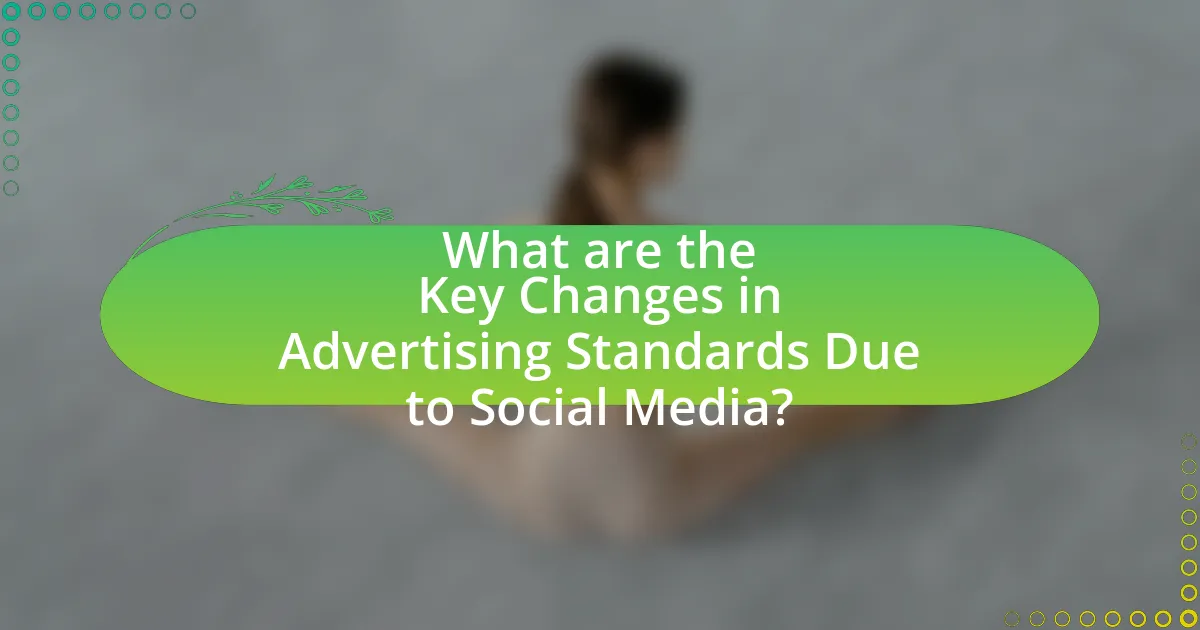
What are the Key Changes in Advertising Standards Due to Social Media?
Key changes in advertising standards due to social media include increased transparency, stricter disclosure requirements, and a focus on authenticity. Social media platforms have mandated that influencers and brands disclose paid partnerships and sponsorships clearly, often requiring hashtags like #ad or #sponsored. According to the Federal Trade Commission (FTC) guidelines, failure to disclose such relationships can lead to legal repercussions, emphasizing the importance of honesty in advertising. Additionally, the rise of user-generated content has shifted standards towards valuing genuine consumer experiences over traditional advertising tactics, as consumers increasingly prefer authentic endorsements from peers rather than polished brand messages.
How have consumer expectations shifted with social media advertising?
Consumer expectations have shifted towards a demand for authenticity and engagement in social media advertising. As users increasingly interact with brands on platforms like Instagram and Facebook, they expect personalized content that resonates with their values and interests. A study by Sprout Social in 2021 found that 70% of consumers feel more connected to brands that engage with them on social media, highlighting the importance of two-way communication. Additionally, consumers now prioritize transparency, with 86% of them stating that they prefer brands that are open about their practices and values, according to a 2020 report by Label Insight. This shift indicates that consumers are not only looking for promotional content but also for genuine interactions and brand integrity in their social media experiences.
What do consumers expect from brands on social media?
Consumers expect brands on social media to engage authentically and respond promptly to inquiries. This expectation stems from the desire for transparency and genuine interaction, as 79% of consumers prefer brands that respond to their comments and messages. Additionally, consumers seek relevant and personalized content that resonates with their interests, which enhances brand loyalty and trust. Brands that fail to meet these expectations risk losing customer engagement and credibility in a competitive digital landscape.
How do transparency and authenticity impact consumer trust?
Transparency and authenticity significantly enhance consumer trust by fostering a sense of reliability and openness in brand communications. When companies openly share information about their practices, values, and product sourcing, consumers are more likely to perceive them as honest and credible. Research by the Edelman Trust Barometer indicates that 81% of consumers need to trust a brand to buy from them, highlighting the critical role of transparency in purchasing decisions. Furthermore, brands that demonstrate authenticity—by aligning their actions with their stated values—tend to build deeper emotional connections with consumers, leading to increased loyalty and advocacy. This correlation between transparency, authenticity, and consumer trust is supported by studies showing that brands perceived as authentic enjoy higher customer retention rates and positive word-of-mouth referrals.
What regulations have emerged in response to social media advertising?
Regulations that have emerged in response to social media advertising include the Federal Trade Commission’s (FTC) guidelines on endorsements and testimonials, which require clear disclosure of paid partnerships. These regulations aim to ensure transparency and protect consumers from misleading advertising practices. For instance, the FTC mandates that influencers disclose their relationships with brands when promoting products, a rule reinforced by various enforcement actions against non-compliance. Additionally, the European Union’s General Data Protection Regulation (GDPR) has implications for social media advertising, emphasizing user consent for data collection and targeted advertising. These regulations collectively address the challenges posed by the rapid growth of social media platforms in the advertising landscape.
What are the key regulatory bodies overseeing advertising standards?
The key regulatory bodies overseeing advertising standards include the Federal Trade Commission (FTC) in the United States, the Advertising Standards Authority (ASA) in the United Kingdom, and the Canadian Radio-television and Telecommunications Commission (CRTC) in Canada. The FTC enforces laws against deceptive advertising and ensures that advertisements are truthful and not misleading, while the ASA regulates advertising across all media in the UK, ensuring compliance with the Advertising Codes. The CRTC oversees broadcasting and telecommunications, including advertising standards in Canada. These organizations play crucial roles in maintaining ethical advertising practices and protecting consumers from misleading information.
How do these regulations differ across various social media platforms?
Regulations differ significantly across various social media platforms, primarily in terms of content moderation, advertising standards, and user privacy policies. For instance, Facebook enforces strict guidelines on hate speech and misinformation, requiring advertisers to adhere to its advertising policies that prohibit misleading claims. In contrast, Twitter has a more lenient approach to user-generated content but has implemented measures to combat harassment and misinformation through labeling and fact-checking. Instagram, owned by Facebook, shares similar advertising standards but emphasizes visual content, requiring influencers to disclose paid partnerships clearly. TikTok, on the other hand, has unique regulations focused on protecting younger audiences, including age restrictions and content guidelines that prioritize user safety. These differences reflect each platform’s target audience and business model, influencing how they implement and enforce their regulations.

What Best Practices Should Advertisers Follow in the Age of Social Media?
Advertisers should prioritize authenticity, engagement, and data-driven strategies in the age of social media. Authenticity builds trust; studies show that 86% of consumers value transparency from brands. Engagement is crucial, as posts that encourage interaction can increase visibility and foster community. Data-driven strategies allow advertisers to tailor content based on audience insights, enhancing relevance and effectiveness. For instance, utilizing analytics tools can help identify peak engagement times and preferred content types, leading to improved campaign performance.
How can brands ensure compliance with advertising standards on social media?
Brands can ensure compliance with advertising standards on social media by implementing clear guidelines that align with regulatory requirements and platform policies. This involves regularly reviewing and updating their advertising content to adhere to the Federal Trade Commission (FTC) guidelines, which mandate transparency and honesty in advertising. Additionally, brands should conduct training for their marketing teams on these standards and utilize compliance checklists before publishing content. Regular audits of social media campaigns can further help identify and rectify any potential violations, ensuring that all advertisements meet the necessary legal and ethical standards.
What steps should brands take to maintain transparency in their advertising?
Brands should implement clear disclosure practices to maintain transparency in their advertising. This includes clearly labeling sponsored content, using appropriate hashtags like #ad or #sponsored, and providing detailed information about the products or services being promoted. Research indicates that consumers are more likely to trust brands that are upfront about their advertising practices, as evidenced by a 2021 study from the American Marketing Association, which found that 78% of consumers prefer brands that are transparent about their advertising. Additionally, brands should engage in open communication with their audience, addressing any questions or concerns regarding their advertising strategies. This proactive approach fosters trust and credibility, essential components in the evolving landscape of advertising standards influenced by social media.
How can brands effectively engage with their audience while adhering to standards?
Brands can effectively engage with their audience while adhering to standards by implementing transparent communication, utilizing data-driven insights, and ensuring compliance with advertising regulations. Transparent communication fosters trust, as brands that openly share their values and practices are more likely to resonate with consumers. For instance, according to a 2021 Edelman Trust Barometer, 61% of consumers prefer to buy from brands that are transparent about their business practices. Utilizing data-driven insights allows brands to tailor their messaging and content to meet audience preferences while remaining compliant with privacy regulations, such as GDPR. Furthermore, adherence to advertising standards, like those set by the Federal Trade Commission, ensures that brands maintain ethical practices, which can enhance brand loyalty and engagement.
What strategies can enhance the effectiveness of social media advertising?
To enhance the effectiveness of social media advertising, brands should focus on targeted audience segmentation, engaging content creation, and data-driven optimization. Targeted audience segmentation allows advertisers to tailor their messages to specific demographics, increasing relevance and engagement; for instance, Facebook’s advertising platform enables precise targeting based on user behavior and interests. Engaging content creation, including visually appealing graphics and interactive elements, captures user attention and encourages sharing, which can amplify reach. Data-driven optimization involves analyzing performance metrics to refine strategies continuously; according to a study by HubSpot, businesses that utilize data analytics in their advertising efforts see a 20% increase in ROI. These strategies collectively improve the effectiveness of social media advertising by ensuring that messages resonate with the intended audience and adapt to their preferences.
How can storytelling improve brand messaging on social media?
Storytelling can significantly enhance brand messaging on social media by creating emotional connections with audiences. When brands share compelling narratives, they engage users more effectively, leading to higher levels of interaction and sharing. Research indicates that stories are 22 times more memorable than facts alone, which underscores their power in capturing attention and fostering brand loyalty. Additionally, storytelling allows brands to convey their values and mission in a relatable manner, making it easier for consumers to identify with them. This approach not only increases brand awareness but also encourages community building around shared experiences and values.
What role does user-generated content play in modern advertising strategies?
User-generated content (UGC) plays a crucial role in modern advertising strategies by enhancing authenticity and engagement. Brands leverage UGC to build trust, as consumers often perceive content created by their peers as more credible than traditional advertising. According to a study by Nielsen, 92% of consumers trust organic, user-generated content more than traditional advertising, highlighting its effectiveness in influencing purchasing decisions. Additionally, UGC fosters community and interaction, allowing brands to connect with their audience on a personal level, which can lead to increased brand loyalty and advocacy.
What are the common pitfalls to avoid in social media advertising?
Common pitfalls to avoid in social media advertising include targeting the wrong audience, neglecting to analyze performance metrics, and failing to engage with users. Targeting the wrong audience can lead to wasted ad spend, as ads may not reach individuals who are interested in the product or service. Neglecting performance metrics prevents advertisers from understanding what strategies are effective, which can result in continued investment in underperforming campaigns. Additionally, failing to engage with users can damage brand reputation, as social media is a platform for interaction and feedback. According to a report by HubSpot, 60% of consumers expect brands to respond to their social media inquiries within an hour, highlighting the importance of engagement.
What mistakes can lead to violations of advertising standards?
Mistakes that can lead to violations of advertising standards include making false claims, failing to disclose sponsorships, and using misleading visuals. False claims can misrepresent a product’s effectiveness or benefits, which is prohibited by advertising regulations. Failing to disclose sponsorships can mislead consumers about the nature of the content, violating transparency requirements. Misleading visuals, such as altered images that do not accurately represent the product, can also breach standards set by regulatory bodies. These mistakes can result in penalties, legal action, and damage to brand reputation.
How can brands recover from advertising missteps on social media?
Brands can recover from advertising missteps on social media by promptly acknowledging the mistake, issuing a sincere apology, and taking corrective action. Acknowledgment demonstrates accountability, while a sincere apology helps to rebuild trust with the audience. For instance, in 2017, Pepsi faced backlash for an ad perceived as trivializing social justice movements; the company quickly pulled the ad and issued an apology, which helped mitigate damage to its brand reputation. Additionally, implementing changes based on feedback can show commitment to improvement, as seen when brands like Dove adjusted their marketing strategies after receiving criticism for lack of diversity.
